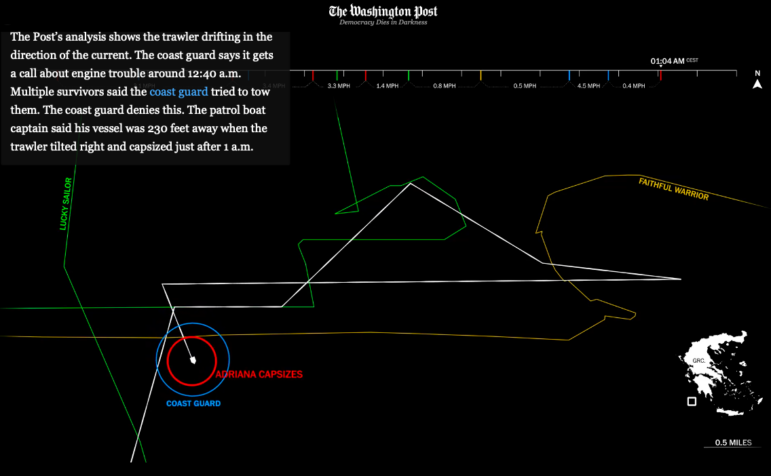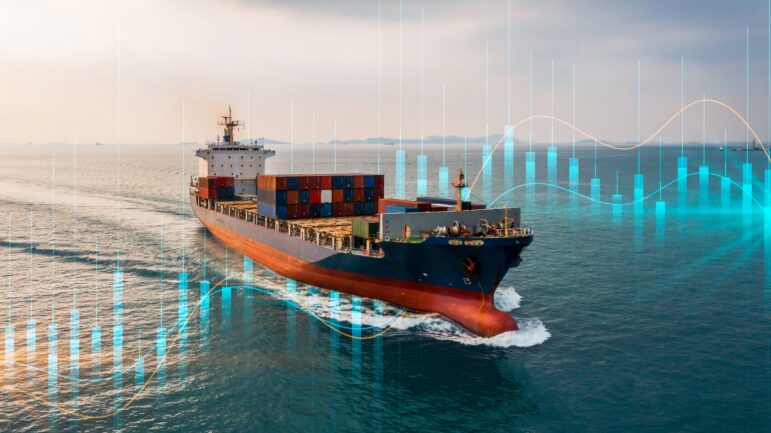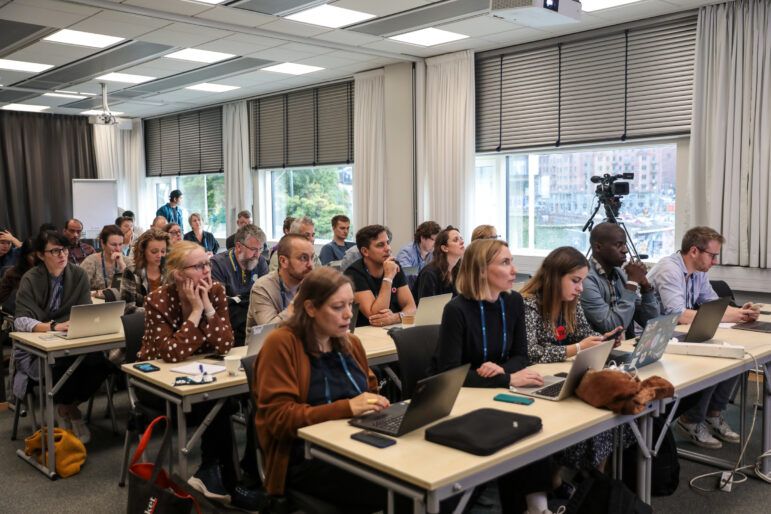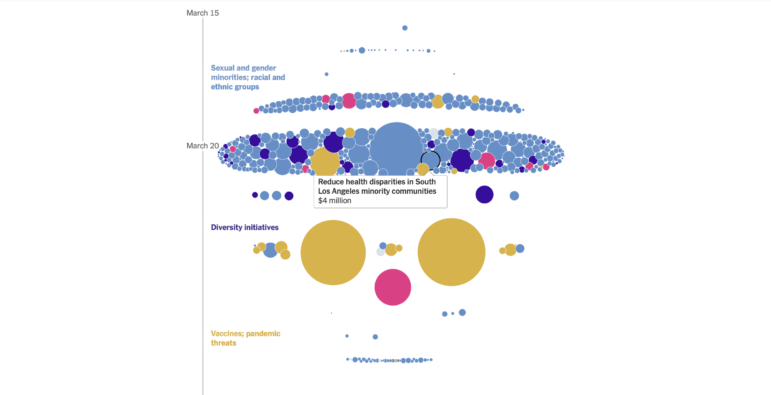

The Washington Post's visual forensics team used various sources to map the path of the Adriana and the vessels that came across its path before it sank. Image: Screenshot, The Washington Post
Data Journalism Top 10: Retracing a Migrant Tragedy at Sea, Nepotism in US Politics, and French Police Brutality
There are still a number of unanswered questions about what happened to the Adriana, a fishing vessel that sank off the coast of Pylos, in Greece, last month. One looming question is if the tragedy, which was the deadliest shipwreck in the Mediterranean in years, was preventable. The Washington Post examined different sources of data in an attempt to piece together what really happened to those on the boat and competing accounts of who was to blame. This week, GIJN also highlights stories on nepotism in political power in the United States, the pressures on the healthcare systems in England and Spain, concerns about climate change, and the best place and time to spot the Loch Ness monster.
Retracing the Adriana
Hundreds of men, women, and children are believed to have drowned when the Adriana, a fishing trawler repurposed into a migrant boat, sank in the Mediterranean Sea last month. The visual forensics team at The Washington Post used satellite imagery, marine traffic data, and integrated coordinates from distress calls and official reports to map what happened. The Post also used interviews with survivors, activists, and maritime experts to examine competing claims about its journey and to explore the various missed opportunities for intervention.
Struggles of the UK’s NHS
During the COVID-19 pandemic, people would come out of their homes to bang saucepans and cheer for the staff of the National Health Service, a national institution that provides free healthcare to everyone in the UK. But as it turns 75, the service is facing mounting pressures. Bloomberg used NHS data to produce a deep dive exploring the problems of waiting lists and missed targets in different parts of England, creating an interactive chart where users can see how the service in their area compares to government targets and the national average. Their findings reveal a “postcode lottery” of indicators like ambulance waiting times and cancer referrals.
US Political Nepo Babies
The US is known for its established political families: from the Kennedys to the Bush dynasty, and even the Frelinghuysen clan of New Jersey, who trace their political ancestry back to the 1800s. According to this story from Business Insider, while these families may be renowned, statistically speaking, parent-child political inheritances they aren’t “that common.” But when reporters looked at how many politicians have a parent famous enough to have a Wikipedia page — i.e., not just political parents — they found a greater number who may have benefited from privilege or nepotism. Insider used this data to chart what they call the “nepo baby rate” in Congress, by political party, and look at how the trend has changed over time.
Record-Breaking Heat
It’s been a blistering hot month for the planet, with the record for the average global air temperature broken first on July 3, then again on July 4, and once again July 6. Now the arrival of the El Niño climate pattern, which brings warmer ocean temperatures to the Pacific, is causing some experts to worry that man-made climate change and natural weather patterns could converge to create “the perfect climate storm.” The Guardian used data to chart and map Antarctic sea ice, average sea surface temperatures in the north Atlantic Ocean, and global temperatures on land and sea, which have also reached record seasonal highs.
German Cities’ Livability in 2050
What will your city be like by 2050? How will living there feel for you, your children, or your grandchildren? In this beautifully illustrated and interactive scrollytelling story, the team at German site BR24 used data from the Bavarian State Environment Office, and best-case and worst-case climate model predictions, to look at how a city like Munich will feel in 27 years time; how many uncomfortably hot “tropical” nights there will be; how the seasons will change; and how rainfall will be altered based on the differing scenarios. Even small changes in temperature can throw the blossom season and animal migrations out of sync, the authors warn, and “this throws nature out of balance.”
Spain’s Healthcare System Under Pressure
In Spain, medics and nurses are feeling overwhelmed, according to this data project from the independent nonprofit organization Civio. Reporters used the country’s transparency law to access data on the workloads of primary care professionals at more than 2,000 health centers, which cater for 72% of the Spanish population. They created a color-coded interactive map that shows the number of patients that family doctors, pediatricians, and nurses see each day in different places, and how that figure has changed over time.
After the Dam Explosion
A significant portion of the Kakhovka Dam in Kherson Oblast, Ukraine, was destroyed last month while under Russian control, unleashing massive torrents of water and flooding dozens of villages and towns. Data journalism agency Texty took a look at how the destruction of the dam affected four irrigation canal systems that supplied water to several regions of southern Ukraine.
French Police Brutality
In recent weeks France has been rocked by protests and riots in the aftermath of the killing of a 17-year-old boy, Nahel M, by a police officer during a traffic stop. Following the incident, the French-language Swiss daily newspaper Le Temps examined the trend of police violence across the world, with the data indicating that French police are relatively aggressive compared to law enforcement in the rest of Europe.
Recycling Gap
The Global Commitment, led by the Ellen MacArthur Foundation, in collaboration with the UN Environment Programme, is an initiative where businesses and governments voluntarily commit to building a circular economy for plastic — to reduce, reuse, and recycle. German news site Berliner Morgenpost took a look at the data reported by some signatories of this commitment. It found a huge gap between the share of plastic packaging produced and recycled by these firms, with the number of plastics produced far exceeding what’s being recycled.
‘Nessie’-spotting
The Loch Ness Monster, affectionately nicknamed Nessie, is a creature that, according to legend, inhabits the eponymous lake in Scotland. Supposedly first spotted by a saint in the 6th Century, the beast has attracted many “monster hunters” over the years. Scottish daily The Press & Journal analyzed more than 1,000 records of Nessie sightings across 1,500 years — from 565 AD to 2023 — to find out the likeliest spot and time to catch a glimpse of the mythical creature.
Bonus: Beyoncé’s Secret
When you think of Beyoncé, R&B and pop immediately typically comes to mind. But rap? Not really. However, an analysis of her songs by data visualization agency TWO-N shows that rap has been creeping into her music more and more over the years.
GIJN’s Data Journalism Top 10 list is curated weekly. Send your suggestions to us.
 Laura Dixon is an associate editor at GIJN and a freelance journalist from the UK. She has reported from Colombia, the US, and Mexico, and her work has been published by The Times, The Washington Post, and The Atlantic. She has received fellowships from the IWMF and the Pulitzer Center.
Laura Dixon is an associate editor at GIJN and a freelance journalist from the UK. She has reported from Colombia, the US, and Mexico, and her work has been published by The Times, The Washington Post, and The Atlantic. She has received fellowships from the IWMF and the Pulitzer Center.
 Eunice Au is GIJN’s global team manager based in Budapest, Hungary. Previously, she was a correspondent for Singapore’s The Straits Times , and a journalist at Malaysia’s New Straits Times. She has also written for The Sun , Malaysian Today, and Madam Chair.
Eunice Au is GIJN’s global team manager based in Budapest, Hungary. Previously, she was a correspondent for Singapore’s The Straits Times , and a journalist at Malaysia’s New Straits Times. She has also written for The Sun , Malaysian Today, and Madam Chair.








